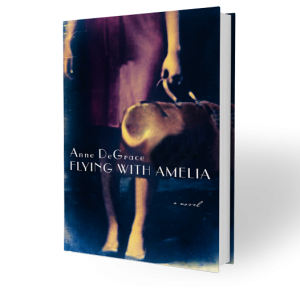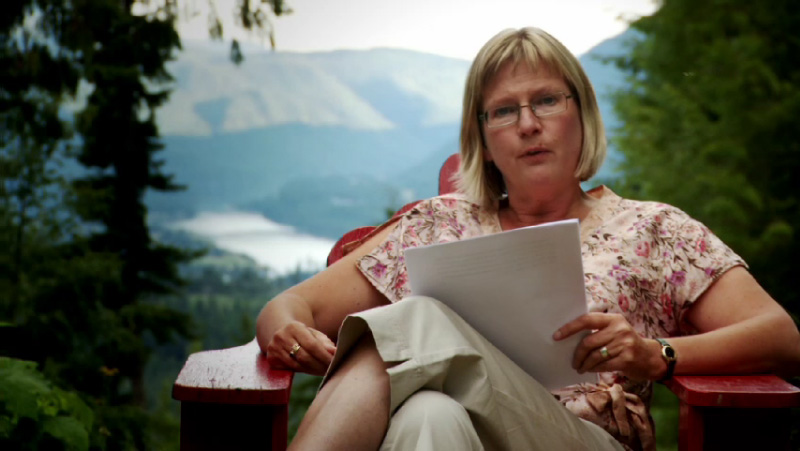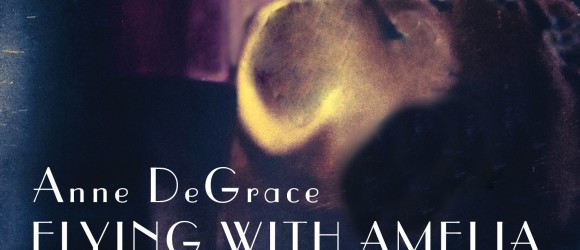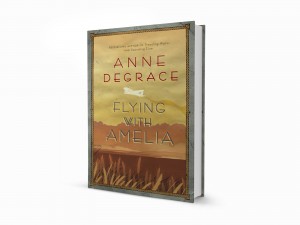Flying with Amelia
 When a coffin ship fleeing the Great Irish Famine arrives in Canada in 1847, it sets off a chain of events that reverberates through generations. In St. John’s, a young apprentice witnesses the first transatlantic wireless signal. In Depression-era Halifax, a young woman answers a personal ad from a Saskatchewan schoolteacher. A British Home Child finds sorrow and solace on an Ontario farmstead. In Montreal, a one-armed man gambles everything for a different future. RCMP officers snatch Doukhobor children in British Columbia; terrorists snatch politicians in Ottawa. And ordinary people find courage in extraordinary times. Peoples with draft dodgers, POWs, adventurers, and even ghosts, Flying with Amelia is a story of collective identity, in all of its colours. Trade paperback published in 2014 by Cormorant Books.
When a coffin ship fleeing the Great Irish Famine arrives in Canada in 1847, it sets off a chain of events that reverberates through generations. In St. John’s, a young apprentice witnesses the first transatlantic wireless signal. In Depression-era Halifax, a young woman answers a personal ad from a Saskatchewan schoolteacher. A British Home Child finds sorrow and solace on an Ontario farmstead. In Montreal, a one-armed man gambles everything for a different future. RCMP officers snatch Doukhobor children in British Columbia; terrorists snatch politicians in Ottawa. And ordinary people find courage in extraordinary times. Peoples with draft dodgers, POWs, adventurers, and even ghosts, Flying with Amelia is a story of collective identity, in all of its colours. Trade paperback published in 2014 by Cormorant Books.
Buy Now (print)
Excerpts
From chapter 4
Murphy Caldwell lights another cigarette, his right hand manoeuvering match against box with a single-handed practice that might astonish the young woman passing the bench on which he sits, should she glance his way. She doesn’t; most don’t look at a one-armed man, but rather avert their gaze… Read More>>
From chapter 5
Dear Mr. Penner, I am writing in response to your advertisement in the Yarmouth Herald for a pen pal. You requested a woman, and I guess I fit the bill. If we are to be pen pals, then it seems important that we strike the right tone, and that it be an honest one. And so I will pledge, Mr. Penner, to be as honest and forthright as I can be if you will promise the same…. Read More >>
Read Review
It’s not often that a book makes me late for drinks with a friend, but I was in the middle of the title chapter of Anne DeGrace’s latest novel, Flying with Amelia, and I had to find out what happens to the characters. And then I had to mop the tears off my face. Read More>>
Audio Clip
Video

Book Club Questions
- It is estimated that between 1831 and 1850 almost 650,000 Irish arrived in Canada to escape the Great Famine. Most Canadians today can trace their roots to somewhere other than Canada. What are the immigration stories—ancestral or more current—among the members of your book club?
- Static opens with a scene of mummers arriving at a Newfoundland kitchen. Is this tradition new to you? What similar traditions exist in other cultures (this is fun to research) and what might be the attraction to these types of hijinks?
- In Home Child, who is Adelaide as a real person in history? Why is Olive’s old friendship with this woman so poignant, given Olive’s present situation?
- Who was Agnes McPhail, and what are her legacies? Why is her speech, paraphrased in Angel, an important message for Murphy and Helen as they navigate their futures?
- The title chapter, Flying with Amelia, includes classic recipes from Newfoundland and Nova Scotia. Find some classic recipes for each Province and Territory. Bring them—or the dish itself. (Potluck opportunity!) While you’re eating, discuss what happened to the On to Ottawa men.
- Many Canadians are unaware that Canada housed German prisoners of war during WWII. Most camps were more secure than the one that formed the backdrop for All of the Colours. How do you think Canadian and German camps compared in terms of treatment of prisoners?
- To be Like You profiles a difficult chapter in BC history. The Canadian Government’s response to the “Doukhobor problem” remains controversial to this day. In the face of arson and terror perpetrated by a splinter faction of a pacifist immigrant group, how might the government of the day have responded better? What are the similarities and differences between the removal of these children and the Japanese-Canadian internment a decade before?
- On March 25, 1969, Pierre Trudeau said: “the status of being a draft dodger doesn’t enter at all into (Canada’s) immigration policy.” For James in A Different Country, it was not that clear-cut. How does this compare with policy for U.S, military deserters during the U.S. war in Iraq? What should Canada’s responsibility be? And how much is (or should be) left to the discretion of the Border Services officers?
- Normal deals with schoolyard bullying against a backdrop of political terrorism. We’ve all been bullied, been bullies, or simply been complicit through inaction, as Maggie is. Discuss your own memories. When does bullying become terrorism?
- In The Language of Bones, Nina can’t shake the ghost of her sister. On Herschel Island, she is visited by ghosts who can’t quite shake their own pasts. By the end of the chapter, Nina and the ghosts of Herschel Island have managed to find a degree of reconciliation in subtle ways. What are they?
- Where were you in 1999, as many prepared for the Y2K “threat”? What were the potential issues as presented by the media, preparedness groups, and others? Did you, or anyone you know go to the extremes that Chantal does in River Rising?
- Each chapter of Flying with Amelia contains links between characters, some overt—such as the relationship of William in the chapter Static to Daniel McGrath in Across the Atlantic—and some subtle, such as in the title chapter when Martin, resting under a tree during the On to Ottawa march, is given flowers by a little girl who hopes he might be her father, and who grows up to be Bernice in To be Like You. Compare the connections you found as you read Flying with Amelia with your group.
Flying with Amelia
When a coffin ship fleeing the Great Irish Famine arrives in Canada in 1847, it sets off a chain of events that reverberates through generations.
In St. John’s, a young apprentice witnesses the first transatlantic wireless signal. In Depression-era Halifax, a young woman answers a personal ad from a Saskatchewan schoolteacher. A British Home Child finds sorrow and solace on an Ontario farmstead. In Montreal, a one-armed man gambles everything for a different future. RCMP officers snatch Doukhobor children in British Columbia; terrorists snatch politicians in Ottawa. And ordinary people find courage in extraordinary times.
Peopled with draft dodgers, POWs, adventurers, and even ghosts, Flying with Amelia is a story of collective identity, in all of its colours.
Click here to order online.
Excerpts
From chapter 4
Murphy Caldwell lights another cigarette, his right hand manoeuvering match against box with a single-handed practice that might astonish the young woman passing the bench on which he sits, should she glance his way. She doesn’t; most don’t look at a one-armed man, but rather avert their gaze…
From chapter 5
Dear Mr. Penner,
I am writing in response to your advertisement in the Yarmouth Herald for a pen pal. You requested a woman, and I guess I fit the bill.
If we are to be pen pals, then it seems important that we strike the right tone, and that it be an honest one. And so I will pledge, Mr. Penner, to be as honest and forthright as I can be if you will promise the same….
Read Review
It’s not often that a book makes me late for drinks with a friend, but I was in the middle of the title chapter of Anne DeGrace’s latest novel, Flying with Amelia, and I had to find out what happens to the characters. And then I had to mop the tears off my face.
From The Notebook
Audio Clip
Video

Book Club Questions
- It is estimated that between 1831 and 1850 almost 650,000 Irish arrived in Canada to escape the Great Famine. Most Canadians today can trace their roots to somewhere other than Canada. What are the immigration stories—ancestral or more current—among the members of your book club?
- Static opens with a scene of mummers arriving at a Newfoundland kitchen. Is this tradition new to you? What similar traditions exist in other cultures (this is fun to research) and what might be the attraction to these types of hijinks?
- In Home Child, who is Adelaide as a real person in history? Why is Olive’s old friendship with this woman so poignant, given Olive’s present situation?
- Who was Agnes McPhail, and what are her legacies? Why is her speech, paraphrased in Angel, an important message for Murphy and Helen as they navigate their futures?
- The title chapter, Flying with Amelia, includes classic recipes from Newfoundland and Nova Scotia. Find some classic recipes for each Province and Territory. Bring them—or the dish itself. (Potluck opportunity!) While you’re eating, discuss what happened to the On to Ottawa men.
- Many Canadians are unaware that Canada housed German prisoners of war during WWII. Most camps were more secure than the one that formed the backdrop for All of the Colours. How do you think Canadian and German camps compared in terms of treatment of prisoners?
- To be Like You profiles a difficult chapter in BC history. The Canadian Government’s response to the “Doukhobor problem” remains controversial to this day. In the face of arson and terror perpetrated by a splinter faction of a pacifist immigrant group, how might the government of the day have responded better? What are the similarities and differences between the removal of these children and the Japanese-Canadian internment a decade before?
- On March 25, 1969, Pierre Trudeau said: “the status of being a draft dodger doesn’t enter at all into (Canada’s) immigration policy.” For James in A Different Country, it was not that clear-cut. How does this compare with policy for U.S, military deserters during the U.S. war in Iraq? What should Canada’s responsibility be? And how much is (or should be) left to the discretion of the Border Services officers?
- Normal deals with schoolyard bullying against a backdrop of political terrorism. We’ve all been bullied, been bullies, or simply been complicit through inaction, as Maggie is. Discuss your own memories. When does bullying become terrorism?
- In The Language of Bones, Nina can’t shake the ghost of her sister. On Herschel Island, she is visited by ghosts who can’t quite shake their own pasts. By the end of the chapter, Nina and the ghosts of Herschel Island have managed to find a degree of reconciliation in subtle ways. What are they?
- Where were you in 1999, as many prepared for the Y2K “threat”? What were the potential issues as presented by the media, preparedness groups, and others? Did you, or anyone you know go to the extremes that Chantal does in River Rising?
- Each chapter of Flying with Amelia contains links between characters, some overt—such as the relationship of William in the chapter Static to Daniel McGrath in Across the Atlantic—and some subtle, such as in the title chapter when Martin, resting under a tree during the On to Ottawa march, is given flowers by a little girl who hopes he might be her father, and who grows up to be Bernice in To be Like You. Compare the connections you found as you read Flying with Amelia with your group.
Sounding Line
 On the evening of October 4, 1967, the tiny fishing village of Perry’s Harbour, Nova Scotia, is invaded: by the “incident”—which sends local fishermen scrambling to find survivors of an assumed plane crash—and by everything that comes after.
On the evening of October 4, 1967, the tiny fishing village of Perry’s Harbour, Nova Scotia, is invaded: by the “incident”—which sends local fishermen scrambling to find survivors of an assumed plane crash—and by everything that comes after.
Young Pocket Snow has a lot to contend with even before the unidentified flying object crashes into the harbour, bringing in its wake military and media interest. That’s because, just as the UFO incident creates a vortex, another is happening within the Snow household as Pocket’s mother approaches death, and his father tries to cope.
At Crosbey’s General Store, Shirley presides as information clearing-house and coffee-pourer, and it is here that locals gather to discuss how the Coast Guard, RCMP, Canadian Navy and U.S. military—a knot of vessels squatting mysteriously out on the Sound—aren’t talking to the people of Perry’s.
While en route to cover the crash, Ottawa reporter Rodney Nowland meets Wanda, a psychic UFO-chaser hoping to communicate with visitors from space. The CBC sends a film crew; a reporter from the Halifax paper is expected at any moment.
Meanwhile the Snow family holds its breath, and yet, with the arrival of strangers, the spark of possibility touches down, alighting briefly upon them all—even Merle Snow. In fact, the incident touches everybody, the people of Perry’s transformed in subtle ways.
Sounding Line is based on a true incident that occurred in 1967 in Shag Harbour, Nova Scotia. The incident attracted national and international news media, and has been the subject of books and documentaries. It is considered Canada’s most significant UFO incident, and is sometimes referred to as “Canada’s Roswell.”
Excerpt
Nobody seemed to have noticed or cared that Pocket hadn’t gone to school. Both his father and Scratch had simply nodded when he came back downstairs without his schoolbooks. After breakfast, Wilf wandered off to Crosbey’s to look for a teapot. When he came back, “they’re all talking about aliens,” he said, and shook his head before holding up both hands, empty. “No teapots,” he said, then: “Call me if you need me. I’m goin out to the shed.”
Review
The way in which DeGrace tells this tale is nothing short of exquisite.
Book Club Questions
- Residents of small, rural communities tend to have a shared history, including intimate knowledge about one another’s past histories—for better or worse. What examples are there in Sounding Line? In your own experience? Do you think this is as prevalent today as it was, say, 50 years ago?
- Nuances of expression, figures of speech, and sometimes nicknames are elements of rural life. What phrases are particular to Sounding Line? What figures of speech do you remember from communities in which you’ve lived? Is this phenomenon similar to teen-speak, or the shared language of another cohort?
- Some characters in Sounding Line believe in things others may find absurd: alien landings, fortune-tellers, harbingers. One man’s superstition may be another’s truth. To what degree do you think superstitions shapes our lives? Can you think of things that you believe to be true, but that you know others do not?
- The author leaves the door open for possibility when it comes to the extraterrestrial and the supernatural, including the existence of heaven, or a life after death. Why do you think she did this? Was this satisfying or dissatisfying for you as a reader?
- In the space of a few days, several characters in Sounding Line learn something about themselves that will help inform their futures, or the way they see the world. What conclusions did Rodney, Pocket, Cuff, Ernie, and Shirley come to in the course of events?
- Pocket and Cuff—two parts to a coat—are as different as they can be. Or are they? What illustrates their differences? Their similarities? What brings them to an uneasy reconciliation?
- What are some examples of humour in Sounding Line? What parts made you smile? Did any parts choke you up? Why?
- The author plays with the concepts of space and depth—what lies beyond what we know. How do these concepts apply to Merle, and her impending death? What examples suggest that Merle is playing with these thoughts, too?
- Between each day as it unfolds is an “interlude” chapter: a short piece written in second person. Who or what do you think is the entity behind the voice? What was the author’s intention in including these?
- Sounding Line is based on a true incident that occurred in Shag Harbour, Nova Scotia, in 1967. What can you find out about this incident online or in books? What do you think came down into the harbour that night?
Wind Tails
 At a side-of-the-highway diner on a mountain pass, during one extraordinary, windy day in 1977, the paths of an odd assortment of travellers cross. The stories of each circle around points of departure: what sets one on one’s journey. These seemingly unconnected—but oddly interconnected—stories involve strange twists, turns, and the kinds of chance encounters that change the way we see the world. There is the old woman who, told she has just weeks to live, tells everyone exactly what she thinks of them—and then doesn’t die; the water witcher who comes to terms with his gift instead of drowning in it; the woman who never leaves her own town but travels vicariously through the tales of the hitchhikers she picks up; a trucker with a kind heart; and the proprietor, Cass, and the story that haunts her. Central to this remarkable day is Pink, travelling in whatever direction the wind takes him, and Jo, a young waitress whose own life twists—family betrayal, and the birth and adoption of a baby—have left her anchorless. For Jo, Cass’s Roadside Café is a waystation, holding her until a series of interactions with strangers give her permission to find her own point of departure, and embark upon her own journey.
At a side-of-the-highway diner on a mountain pass, during one extraordinary, windy day in 1977, the paths of an odd assortment of travellers cross. The stories of each circle around points of departure: what sets one on one’s journey. These seemingly unconnected—but oddly interconnected—stories involve strange twists, turns, and the kinds of chance encounters that change the way we see the world. There is the old woman who, told she has just weeks to live, tells everyone exactly what she thinks of them—and then doesn’t die; the water witcher who comes to terms with his gift instead of drowning in it; the woman who never leaves her own town but travels vicariously through the tales of the hitchhikers she picks up; a trucker with a kind heart; and the proprietor, Cass, and the story that haunts her. Central to this remarkable day is Pink, travelling in whatever direction the wind takes him, and Jo, a young waitress whose own life twists—family betrayal, and the birth and adoption of a baby—have left her anchorless. For Jo, Cass’s Roadside Café is a waystation, holding her until a series of interactions with strangers give her permission to find her own point of departure, and embark upon her own journey.
Reviews
Anne DeGrace, author of 2005’s Treading Water, sets her new novel during a single day in 1977 in a remote diner in a B.C. mountain pass. The story is primarily about Jo, a troubled teen waitress still recovering from an unexpected pregnancy, and Cass, the owner of the diner. But the staff at Cass’s Roadside Café are only a launching point for an expansive novel that encompasses each and every person who enters the diner during the day. The full cast totals more than a dozen, with twice as many characters in supporting roles. Read More>>
A self-described ‘story vulture,’ Anne DeGrace confesses her second novel Wind Tails (McArthur & Co. $29.95) arose from a pub night in Nelson when a friend described a hitchhiker who would only travel in the direction the wind blew. A second friend added a true story about a driver who asked hitchhikers to send him postcards from wherever they wound up. Read More >>
Excerpts
It’s the first day of the third week. Jo never thought she’d get used to starting work at six a.m., but the truth is, she’s starting to like it. Even college classes, when she last attended, didn’t require rising so early, and then mornings included the bustle of her mother heading off to work at the clinic, her father’s newspaper rattle at the kitchen table, the morning banter—on the good days—between them. It’s September: she should be at home, just starting second year, perhaps sharing an apartment with other students. Read More >>
Book Club Questions
- Being true to an era means, for a writer, including small details that set us firmly in time. A CB rather than a cell phone for a trucker; an urn-style coffee percolator rather than an espresso machine in a restaurant. What are some other details in Far from Home that set us clearly in the 1970s.
- Eamon is a poser, pretending to be something he is not in order to get what he wants. What are some other examples of people pretending to be what they are not: in the novel, in the news, and in people you’ve encountered in your own life?
- Jo opts for adoption rather than abortion. Why? Why doesn’t she choose to keep the baby? What might the times have to do with her decision?
- Sometimes it is a particular event that sets us on the road, or changes our direction. Eunice has a near-death experience; Evelyn’s husband is having an affair; Carson is framed. What sets Pink on the road to Canada? Is it one thing, or an accumulation? What makes him alter his rule of the road? What have been the turning points in your life?
- The people we encounter in our lives change the way we see the world. Sometimes it comes by way of advice, sometimes it’s a negative experience, and sometimes it’s so subtle we can’t see it at all. What advice does Jo receive, either subtly or overtly? What’s the best advice you’ve ever received, and where did it come from?
- Eccentricity plays a large role in Far from Home. Aunt Bea collects cut-out eyes from magazines; Evelyn is a floral kleptmaniac; Granny lives in the woods, and Pixie brings her food in exchange for stories. These characters are all based on real people. Eccentric people color our lives, but when does eccentricity cross the line to become mental illness? How do we know? Discuss eccentric people you have known.
- Evelyn collects hitchhikers. Pink collects rides. The seed for Far from Home took root when the author was swapping hitchhiking stories with friends. How has the culture of hitchhiking changed since the 1970s? Have you ever hitchhiked? Picked up a hitchhiker? Would you? Swap your own stories.
- Kindness is doing a good turn for its own sake. It’s being empathetic to the feelings of others, perhaps recognizing or anticipating a need. What are some examples of kindness in Far From Home?
- Far from Home features a disparate cast of characters, some more likeable than others. What characters do you like? Not like? Why? What do you think was the author’s intention?
- What decision does Jo make at the end of the novel? Where will she go now? Suggest what might happen to Jo in the next month, or even year. Compare outcomes with other members of your book group.
Interview
This interview for Far From Home (U.S.) published by HarperCollins/Avon (Wind Tails in Canada) appears in the A+ section of the trade paperback edition.
The stories in Far From Home are each distinct and yet interconnected. How did these connections come to you?
I really do see people as vessels full of stories, as Granny tells Pixie. These stories include the stories of one’s life, and the stories we collect as we encounter the stories of others. They all touch us in some way. At times, it’s obvious: we’re touched by something, and it changes the way we see a person or situation, or even ourselves. At other times it’s less obvious; it’s the layering of stories that slowly, over time, changes us. In Far from Home I started with Jo and Pink: two young people in search of something. I also had a number of stories and characters in my back pocket, so to speak. With each new character who entered the story I thought: who is this person? What do their stories mean to them? How will they touch Jo, and how will Jo, in turn, touch them? As I wrote, the characters and their stories—just sketches at first—grew through the telling, and then took on another dimension at Cass’s Roadside café. For Jo, the stories she picks up are subliminal, but the reader knows the true story.
If there’s one thing the travelers who come through the diner have in common, it’s that they are all misfits in some way. Do you see yourself that way?
We all see ourselves as misfits in a way, I suppose, or perhaps we like to think of ourselves that way, because I sets us apart. When does “different” become simply “odd?” It’s a fine line, and one that fascinates me. I love eccentric people; I seem to surround myself with them. They are the out-of-the-box thinkers, the artists, the wacky scientists for whom the world seems just a little more colourful, its spark burning just a bit brighter. I wouldn’t say I’m a misfit, but some days, I aspire to be one just for that reason.
What are your thoughts about the connections between people? Do you believe in coincidence? Does everything happen for a reason?
That’s a great question. The practical side of me believes in the randomness of all things, and I admit I take some comfort in that. I am delighted by serendipity, and the magic of coincidence. And then there’s the random serendipity of coincidence that is so pointed there’s nothing to do but sit up and say: Wow. Obviously, there’s a lesson to be learned, here. When that happens, it’s hard to imagine there was no orchestration involved. And so I suppose I was playing with that in Far from Home: the convergence of seemingly disparate people propelled by unusual circumstances that, encountered by one person, change that person’s view of the world. The nice thing is that we don’t really need to know if life’s serendipities are random or divine in order to appreciate them.
At one point in the book Eunice says: “You know what I’ve figured out? That life keeps slapping you in the face with a lesson ’til you learn whatever the lesson is you’re supposed to learn.” I really believe that.
Many of the characters in the novel express a certain amount of longing, sometimes regret. Is there a message here?
I try not to write with any overt message in mind. To me, fiction—like all art—is a reflection of what we see around us. There is longing in the world, from the abstract—longing to belong, longing to be loved—to the concrete: longing for a warm bed or a hot meal. It’s pretty universal, just as regret is something everyone experiences. By exploring a theme through writing, I suppose I learn something about it on a subtle level. There are other themes in the book as well, you could say, such as optimism or hope, or the value of the journey, rather than just the destination.
I don’t think about it all that much when I’m writing, honestly. There’s just a story I want to tell. But I like that themes do emerge in the process. I suppose a painter experiences the same thing, when, through layered applications of paint, an unexpected quality emerges.
The characters in Far From Home come from different backgrounds. Do you have to do a lot of research into things like midwifery or dowsing?
The short answer is that the amount of research I do is just enough. Research, in itself, is very seductive. It’s awfully tempting to go deeper and deeper into the minutiae of a subject and never write a word. Writers of period novels, or political or scientific novels, really do need to know their subject. You can’t fudge the details, because someone out there is an expert and they’ll call you on it. Literary license is a wonderful thing, but you can only push it so far. So I try to make sure I know my stuff, but not spend so much time researching that the book won’t get written. One thing I always do is ensure I have plenty of readers who will catch my mistakes, so if there weren’t cell phones in 1977, Archie had better not be talking on one.
What about those readers? Are they friends? Other writers?
I have a writing group to whom I owe a great deal. Each brings something to the critique I hadn’t anticipated, and we often wind up with lively discussions about whether a character would say a certain thing. They ask me hard questions that need to be asked. When we’re finished critiquing one another’s work, we have a “staving artist” dinner: soup, bread, cheese, and wine. I wouldn’t trade it for anything. I believe anyone who wants to write, at any stage, should find a writing group. When the first draft of a manuscript is finished, I have several writers and friends, in addition to the group, who give me feedback.
Have they ever told you to start over?
(laughing). Yep.
When do you write? Do you have a set time?
Not really. I admire writers who, say, get up at 4 am and write ’til 7 am every morning. When my kids were all still at home—I was a single mother—I had the computer in the living room, partly so everyone was forced to interact with one another. I think in too many families, kids wind up sequestered in a “computer room” or in their own rooms. But the other reason the computer was there was because there really wasn’t another place to put it. Consequently, I wrote whenever the thing was free. I often wrote when the kids were at school, but if I was on a roll, I became very good at tuning out whatever was going on around me, short of a house fire. It drove the kids crazy, in a way, but they got used to it, and there doesn’t seem to be any lasting damage. And I got the book written.
You write on a computer, then. Do you ever write longhand? Does it come easily?
Sometimes it does, and then—this is going to sound a little flaky—it’s as if the muse is sitting just above my right shoulder feeding me words that travel through my fingers and out onto the keyboard. I imagine this thing to look something like Gizmo the Gremlin, only perhaps green and more disheveled. Other times, Gizmo’s off starring in some 80s movie and I’m left with paralyzed fingers. That’s when bizarre things happen in my house, like a sudden cleaning of the cupboard under the kitchen sink. My house is never cleaner than when the words won’t come. I never write longhand. I can’t read my own handwriting after about five minutes.
Did you always want to write?
When I was a kid, I wanted to be a visual artist, a painter or an illustrator. Writing surprised me by being a more comfortable creative medium, as I discovered when I began writing a regular column for a newspaper about the local arts scene. It’s not always easy to erase a line or paint over a canvas, but words are endlessly malleable, and I love that. I love that if you come back to your words a day later, they have suddenly acquired their own distinct personalities, somewhat separate from their writer. It’s lovely. I’ll look at something I wrote, delighted to make a new, vaguely familiar acquaintance.
I admire all creative people. I revere the dancers, the actors, the filmmakers, the painters, the musicians. If I could choose any art to be something I did well, it would be music, for its ability to evoke emotion so immediately. You have to pick up a book, but you can catch a song when you’re riding a bus, and it becomes the soundtrack for your day. Without even expecting it, it can warm your heart, or make you cry. As a writer I try to do the same thing—it just takes me three hundred pages to do it!
It sounds like music is important to you. Does it have any influence on your writing?
Funny you should ask. An early draft of the novel was set during the Vietnam war, at the height of student protest and the Civil Rights Movement. So my personal soundtrack included songs like Joni Mitchell’s Woodstock, Blind Faith’s Can’t Find my Way Home, and Neil Young’s Ohio. I let David Crosby sing to me about the Chicago Seven while I wrote. When I re-set the story in 1977—in part, ironically, to regain my original sense of direction—I had to update my playlist! So my new soundtrack became the kind of am radio tunes I imagined Jo would have listened to around that time: Wish you Were Here by Pink Floyd, Fly Like an Eagle by the Steve Miller Band, Fleetwood Mac’s Go Your Own Way, and Long May you Run by Neil Young and Stephen Stills. I could clearly imagine Jo wiping the counters at Cass’s while, on a tinny two-knob plastic radio in the kitchen, Bruce Springsteen sings: Baby, you were born to run.
When you read, what makes a perfect novel for you?
I want a good story, and I want characters I care about. There doesn’t need to be a lot of action, but there does need to be enough depth to make me think, and make me care. I can admire a writer for the crafting of the story, or the character development, or my need to turn the page. But the very best writers are painters with language. Or master chefs. They make me want to eat the words, to savour them. These are the writers I admire most.
Any advice for up-and-coming writers?
Trust. It takes a tremendous amount of trust—in yourself, in the story you want to tell—to be able to write. If you can trust, you’re halfway there.
Far From Home
 When circumstances set 19-year-old Jo on the road, she doesn’t quite know where she is going—she’s just going. But due to the kindness of strangers, she finds her way to Cass’s Roadside Café, a side-of-the-road diner on a mountain pass in the middle of nowhere.
When circumstances set 19-year-old Jo on the road, she doesn’t quite know where she is going—she’s just going. But due to the kindness of strangers, she finds her way to Cass’s Roadside Café, a side-of-the-road diner on a mountain pass in the middle of nowhere.
There, during one extraordinary, windy day in 1977, she meets an odd mix of travelers: an old woman who, informed she only has a few weeks to live, tells everyone exactly what she thinks of them—and then doesn’t die; a water-witcher who has had to come to terms with his unusual talent; a hippie who travels wherever the wind takes him; a friendly trucker; and a cast of local characters whose pasts have taught them invaluable lessons, and whose stories give Jo the strength and courage to face her past and depart on her own journey, once again.
:: Far from Home is published as Wind Tails in Canada. For exerpts, reviews, and book club questions please see Wind Tails (click here)>>
Treading Water
 The voices of the residents of Bear Creek surface in Treading Water, a novel in twelve stories. Gus Sanders, a young trapper, arrives to seek his fortune in 1904, but loses his heart, and then his life; Jake Schroeder must choose between his wartime desire to join up and his Mennonite pacifist roots; Isobel Grey, suffragette, escapes the Winnipeg protests and brings her politics with her; Dutch war bride Aliesje Milner, six months pregnant, waits at the train station for a husband whose face she can no longer remember; and young Paul Doyle’s summer job demolishing houses to make way for the new hydroelectric dam teaches him more than he bargained for. The indomitable personality of Ursula Hartmann, first child born in Bear Creek and among the last residents to leave, threads through the chapters as they trace a community from its hopeful beginnings until the day the waters rise.
The voices of the residents of Bear Creek surface in Treading Water, a novel in twelve stories. Gus Sanders, a young trapper, arrives to seek his fortune in 1904, but loses his heart, and then his life; Jake Schroeder must choose between his wartime desire to join up and his Mennonite pacifist roots; Isobel Grey, suffragette, escapes the Winnipeg protests and brings her politics with her; Dutch war bride Aliesje Milner, six months pregnant, waits at the train station for a husband whose face she can no longer remember; and young Paul Doyle’s summer job demolishing houses to make way for the new hydroelectric dam teaches him more than he bargained for. The indomitable personality of Ursula Hartmann, first child born in Bear Creek and among the last residents to leave, threads through the chapters as they trace a community from its hopeful beginnings until the day the waters rise.
Reviews
The writing is clear as a bell, the language crisp and clean, the stories often very moving. This a remarkable debut. Read more >>
…an immensely readable and realistic novel. Read more>>
Excerpts
Chapter 1
The axe lies against the chopping block to his left. There is no question: wood is required. He chooses not to think, but instead seizes the axe in a swift movement, the familiar shape fitting reassuringly into his palm. In a moment there is wood on block, axe in air, pieces on ground. But there is the slicing pain on the downswing, as if he has cut off his own foot with the axe, and with the biting shift of weight from foot to foot, the sharpness of the day rises, then falls. Read more>>
Chapter 12
When I got the job holding the hose for the house burnings I figured: hey, it’s a job. It’s not like anything I could say or do will make any difference to this backwater called Bear Creek. It’s all going to be under water—35 feet of water—in a few months’ time, and by then we’ll all be long gone. Read more>>
Audio interview
Sheryl McKay of CBC Radio’s NXNW interviews Anne. Listen to Mp3
Book Club Questions
1. 1904: The first chapter closes with the death of its principle character. Did this surprise you? Why do you think the author did this?
2. 1905: Three women come together for the birth of Ursula: Justine, Birthe, and of course, Frieda. How does Justine’s cultural background help or hinder the situation? What common sensibilities do they all share with regard to babies and husbands?
3. 1915: Jake is also caught in a cultural dilemma. What might his father have said when they received notification of his death? His mother? How might the community have responded?
4. 1919: How does Isobel’s past work with the suffragette movement affect how she sees the world? Why might an animal bridge differences?
5. 1921: What other authors have used shell-shock (post traumatic stress disorder) as a basis for works in fiction or nonfiction? Little was known about the disorder at the time of the First World War. What is known today?
6. 1932: This chapter, although set in a particular place and time, could easily happen in a different place or time. What themes make this story universal in nature?
7. 1936: Two parallel characters—Duncan and Ursula—never find a point of connection as their perceptions of the situation are completely different. Has this ever happened to you?
8. 1946: War brides were courageous. In their home countries, some also said they were foolish, knowing little of the place they were going or even the men they married. What stories of war brides do you know and can share?
9. 1950: How is the flood a metaphor for loss and grief? What resolution is suggested by the way the chapter ends?
10. 1954: By the end of the chapter, Ellie has gone too far to turn back. Discuss the contributing factors to her choice. Does Tom accept it?
11. 1965: Land expropriation for dam development has affected people all over the world. Is the displacement of a few to provide hydroelectricity to many inevitable? Is it right?
12. 1967: Some residents can only look forward when crossing on the ferry for the last time. Others look back. Which would you be? Why?
13. The author has structured this book as a novel told in twelve separate stories. What do you think of this structure? Some characters show up again and again, while other do not. Which characters would you like to know more about?


